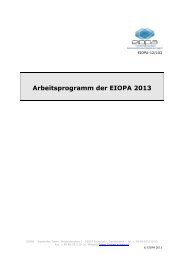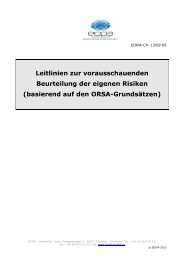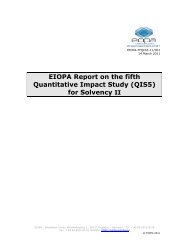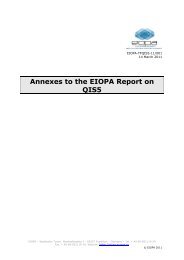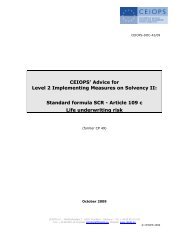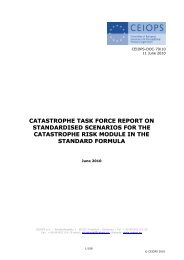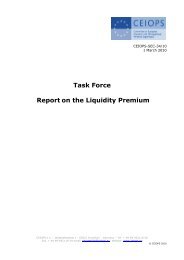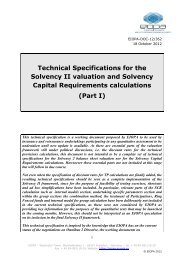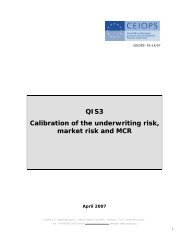Answers to the European Commission on the ... - Eiopa - Europa
Answers to the European Commission on the ... - Eiopa - Europa
Answers to the European Commission on the ... - Eiopa - Europa
You also want an ePaper? Increase the reach of your titles
YUMPU automatically turns print PDFs into web optimized ePapers that Google loves.
Risk classificati<strong>on</strong><br />
10.23 To <str<strong>on</strong>g>the</str<strong>on</strong>g> extent possible, Pillar I quantitative requirements should be<br />
designed <str<strong>on</strong>g>to</str<strong>on</strong>g> address <str<strong>on</strong>g>the</str<strong>on</strong>g> main financial risks <str<strong>on</strong>g>to</str<strong>on</strong>g> which an insurance<br />
undertaking is exposed. As a general principle, a Pillar I treatment may<br />
be applied <str<strong>on</strong>g>to</str<strong>on</strong>g> any risk which is susceptible <str<strong>on</strong>g>to</str<strong>on</strong>g> quantificati<strong>on</strong> or<br />
limitati<strong>on</strong>. However, risks may be excluded from an explicit<br />
requirement in Pillar I if, for example:<br />
• <strong>on</strong> average, <str<strong>on</strong>g>the</str<strong>on</strong>g> risk is c<strong>on</strong>sidered marginal;<br />
• simplifying assumpti<strong>on</strong>s can be made; or<br />
• a standardised risk treatment would not be practicable.<br />
By c<strong>on</strong>trast, Pillar II should c<strong>on</strong>sider all risks, even if <str<strong>on</strong>g>the</str<strong>on</strong>g>y cannot be<br />
quantified. The relative emphasis <strong>on</strong> Pillar II requirements in <str<strong>on</strong>g>the</str<strong>on</strong>g><br />
solvency framework will depend <strong>on</strong> <str<strong>on</strong>g>the</str<strong>on</strong>g> adequacy of Pillar I treatments.<br />
10.24 It should be noted that <str<strong>on</strong>g>the</str<strong>on</strong>g>re is no unique way of breaking down risks<br />
in<str<strong>on</strong>g>to</str<strong>on</strong>g> categories. A categorisati<strong>on</strong> that provides a good fit <str<strong>on</strong>g>to</str<strong>on</strong>g> <str<strong>on</strong>g>the</str<strong>on</strong>g> risk<br />
profile of <strong>on</strong>e undertaking may be less appropriate in o<str<strong>on</strong>g>the</str<strong>on</strong>g>r<br />
circumstances. This will depend largely <strong>on</strong> <str<strong>on</strong>g>the</str<strong>on</strong>g> nature, scale and<br />
complexity of <str<strong>on</strong>g>the</str<strong>on</strong>g> business undertaken by an individual undertaking. In<br />
additi<strong>on</strong>, <str<strong>on</strong>g>the</str<strong>on</strong>g> practicability criteri<strong>on</strong> means that some subcategories of<br />
risk could be treated in a Pillar I internal model, but not a Pillar I<br />
standardised formula.<br />
10.25 Based <strong>on</strong> <str<strong>on</strong>g>the</str<strong>on</strong>g> work of <str<strong>on</strong>g>the</str<strong>on</strong>g> IAA, <str<strong>on</strong>g>the</str<strong>on</strong>g> risks faced by a typical insurance<br />
undertaking could be categorised under five major headings:<br />
• underwriting risk: specific insurance risk arising from <str<strong>on</strong>g>the</str<strong>on</strong>g><br />
underwriting of insurance c<strong>on</strong>tracts, associated with both <str<strong>on</strong>g>the</str<strong>on</strong>g><br />
perils covered and <str<strong>on</strong>g>the</str<strong>on</strong>g> processes followed in <str<strong>on</strong>g>the</str<strong>on</strong>g> c<strong>on</strong>duct of <str<strong>on</strong>g>the</str<strong>on</strong>g><br />
business;<br />
• market risk: risk arising from <str<strong>on</strong>g>the</str<strong>on</strong>g> level or volatility of <str<strong>on</strong>g>the</str<strong>on</strong>g> market<br />
prices of financial instruments;<br />
• credit risk: <str<strong>on</strong>g>the</str<strong>on</strong>g> risk of default and change in <str<strong>on</strong>g>the</str<strong>on</strong>g> credit quality of<br />
<str<strong>on</strong>g>the</str<strong>on</strong>g> issuers of securities, counterparties (notably reinsurers) and<br />
intermediaries <str<strong>on</strong>g>to</str<strong>on</strong>g> whom an undertaking has an exposure;<br />
• operati<strong>on</strong>al risk: risk of loss resulting from inadequate or failed<br />
internal processes, people, systems or from external events;<br />
• liquidity risk: exposure <str<strong>on</strong>g>to</str<strong>on</strong>g> loss in <str<strong>on</strong>g>the</str<strong>on</strong>g> event that insufficient<br />
liquid assets will be available <str<strong>on</strong>g>to</str<strong>on</strong>g> meet <str<strong>on</strong>g>the</str<strong>on</strong>g> cash flow requirements<br />
of policyholder obligati<strong>on</strong>s as <str<strong>on</strong>g>the</str<strong>on</strong>g>y fall due, or <str<strong>on</strong>g>the</str<strong>on</strong>g> assets may<br />
<strong>on</strong>ly be realised under excessive costs<br />
In view of <strong>on</strong>going work by <str<strong>on</strong>g>the</str<strong>on</strong>g> Joint Forum, liquidity risk has been<br />
added as a separate risk category.<br />
86



